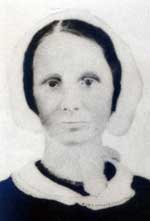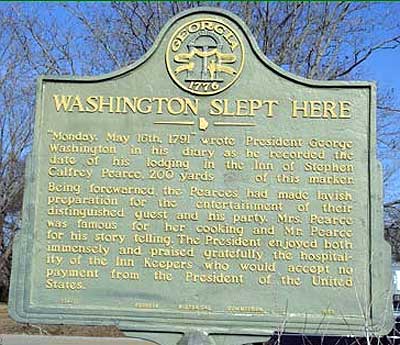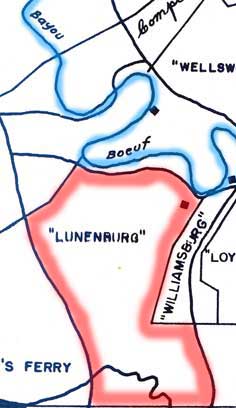The Munsons of Texas — an American Saga
Chapter Eight
THE STORY OF THE PEARCE FAMILY [1]
SUMMARY

Ann Binum Pearce
Ann Binum Pearce, the "grandmother" of all of the Munsons and Caldwells of Texas, was descended from an old and distinguished southern American family. It is reported that in 1607 or 1609, a William Pierce (or Pearce) arrived in the colony of Jamestown, Virginia, the earliest permanent English settlement in America. His descendants migrated to the Carolina Colony in the early eighteenth century, were among the first settlers in Screven County, Georgia, in 1768, and moved to the newly acquired Louisiana Territory in l803. There, 17-year-old Ann Pearce met Henry William Munson and they were married in 1817.

In 1606 King James I of England granted a charter to the London Company for settlement and development of the territory of Virginia (extending from present day Pennsylvania to South Carolina) in the new world of America. The London Company was a business with plans to make money by establishing a trading post and searching for gold and silver. In 1607, after five months at sea, the 104 original settlers — 120 set out from England and sixteen died at sea — sighted land near Chesapeake Bay and sailed thirty-two miles up the James River to a site which they named Jamestown.
These early settlers were not prepared for life in the wilderness, and many of them died of hunger, malaria, and lack of shelter, or were killed by the Indians. The colony barely survived the "starving time" during the first two winters under the leadership of John Smith, who returned to England in 1609. In 1610 the colonists abandoned the colony and boarded ships to return to England, but at the entrance to Chesapeake Bay they met the ships of Lord Delaware bringing supplies and new colonists, and all returned to Jamestown under the leadership of John Rolfe.
In 1612 the colonists began the profitable raising of tobacco. In 1614 John Rolfe married Pocahontas, the daughter of the powerful Indian chief Powhatan, and the struggling colony enjoyed peace with the Indians until Powhatan died in 1618. In 1619 the first black slaves were introduced to work the tobacco farms, and in that year the Virginia House of Burgesses, the first representative assembly in the new world, was established. The thriving colonists established plantations inland on both sides of the James River, and in 1622 a severe Indian raid killed about 350 colonists. Famine and disease further reduced the population to about 1,200 persons. The Munsons' ancestors — William Pierce, his wife Jane, and their children — were among the survivors.
Bits of information show one or several Pierces or Pearces joining the earliest settlements at Jamestown [2]. In 1607 or 1609 a William Pierce arrived in Virginia, coming across the sea with Sir Thomas Gates on the ship Sea Venture. His wife, Mrs. Jone [Jane] Pierce, followed in the Blessing. In 1619 a land patent was granted to "Master Pierce who has undertaken to transport to Virginia great multitudes of people with store of Cattle". A letter dated April 11, 1623, describes Lieutenant Pearce as "the fairest in Virginia", and a document dated May 29, 1623, names Lieutenant Pierce as "governor of James Town". In 1623 and 1624 Captain William Pierce and wife Jane were living at James Town. In 1620, Jane, the daughter of Captain William Pierce, married John Rolfe as his third wife. William Pierce and John Rolfe owned lands on Mulberry Island in the James River, and William Pierce was one of the most prominent men of the Colony. In 1629 Mrs. Pierce visited England after spending twenty years in America. This indicates her arrival date to be 1609.
J. C. Hotten's List of Emigrants to America reports that on January 24, 1624, William Pearce owned a plantation on Mulberry Island with thirteen servants. He was a member of the "Council" (i.e. of James City County) in 1631. And further, Hotten records that "Captain William Peerce patented 200 acres of land nere Mulbery Island in the corporation of James Cittie in 1636", and that on August 1, 1635, "Steeven Pierce, aged 30, was licensed to go beyond the seas on the ship Elizabeth of London with Christopher Browne, Master".
One of William Pearce's descendants, Stephen Pearce Sr.1, was born in Virginia and emigrated to the Carolina Colony early in the eighteenth century. There he married a Miss Lanier of the family of poet Sidney Lanier of Georgia. They had three sons: Stephen2, Joshua2, and William Leigh2, the last being born in about 1740 in North Carolina. Joshua2 was the ancestor of the Munsons of Texas. [See Chart 4].
Nothing is known of Stephen2, the eldest brother. He may have died young.
The youngest son, William Leigh2, received a liberal education and was one of the early exponents of the cause of independence for the colonies. He became a captain in the First Continental Artillery and a member of the Sons of Liberty in Savannah. The Cyclopedia of Georgia, edited by ex-Governor Allen O. Chandler and General Clement A. Evans, says of William Leigh Pearce: "His first service was as aid-de-camp to General Greene. At the battle of Eutaw Springs, he distinguished himself by his bravery for which he was given a sword by Congress, and was promoted to rank of major." In the years 1786-1787, he served as a delegate to the Continental Congress, and in 1787 he was a member of the Federal Convention that convened in Philadelphia to write the U. S. Constitution. He died on December 10, 1789, at about the age of 49, just five months too soon to witness the inauguration of the first President of the United States.
Stephen1 Pearce's second son, Joshua2, was Ann Binum Pearce's grandfather. He was born around 1730 in North Carolina, and in about 1752 he married Hannah Green, probably also of North Carolina. They had four known children: William3 (Ann Binum's father), born about 1754, Joshua3, Stephen Calfrey3, and Sarah3. Old Joshua2, as he came to be known, appears in Georgia in July of 1768, making application for a grant of 150 acres of land on Buck Creek in St. Matthew's Parish. His application stated "That he had been in the Province of Georgia for four months from North Carolina, had no lands granted to him previously in Georgia and had a wife, six children, and negroes". He received a Royal land grant from King George III in 1769.
Old Joshua2 was appointed Surveyor of Roads for Effingham County in 1777. In 1778 a Georgia Act was passed under which five commissioners were appointed from each county as representatives to the State. The five commissioners from Effingham County included Joshua Pearce.
In 1782, when the Assembly met in Augusta, a sweeping Act of Attainder and Amercement (loss of civil rights and punishment) was passed. This was apparently an act of retribution against those who had supported the British crown. Many whose names were found on this list charged as Tories were men who had positions of trust during the early years of the Revolutionary War and were leading men in the State. Joshua Pearce Sr. appears in this list. His property was not confiscated and after three years of military service he was restored to citizenship. In many cases where the father had been a Loyalist the sons were Whigs, and many on these lists were not clearly Tories or Loyalists at all. This is further indication of the split and uncertain loyalties of the British subjects in America during the American Revolution.
Quoting from McCall-Tidwell and Allied Families: "Joshua was a leader of Methodism in the State of Georgia. He was a man of great intelligence and energy, a planter of importance, and deeply interested in his state and nation. His reputation still endures in several Georgia counties — Effingham, Screven, Bullock, and Burke — with veneration and respect."
One of the dearest family traditions of the Pearce family tells how Old Joshua Pearce2 operated a highly-regarded inn on his homestead in St. Matthew's Parish; and how Pearce's Inn was made historic by the overnight visit of President George Washington in the course of his memorable ride from Savannah to Augusta in 1791, during his visit to the South. Today a Georgia state historical marker marks the spot and relates the story. It is located in Screven County on State Highway 24 between the county seat of Sylvania and the Savannah River. Then in 1825 Stephen Calfrey Pearce3, the son of Joshua2, entertained the Marquis de LaFayette in the same room of this same old inn on LaFayette's visit to the South.
Old Joshua Pearce2 raised three sons and a daughter. Son Stephen Calfrey3 married Mary Wills of the prominent Wills family of South Carolina. He maintained his father's plantation and position in Georgia. They raised seven known children who founded the sizable Pearce family of Georgia. The youngest, Mary, was married in 1810 to Paul Beville Jr. One of their descendants, Agnes Beville Vaughn Tedcastle, wrote the Beville genealogical history, The Beville Family of Virginia, Georgia and Florida, in about 1917. This book contains much of the older Pearce genealogy related here.
Joshua2 Pearce's second son, Joshua3, moved with his family from Screven County, Georgia, to the Mississippi Territory in 1807. He received grants of land in the Natchez District and founded the Mississippi branch of the Pearce family. It seems very possible that he may have become acquainted there with the Munsons and this might have been the link of introduction between Henry William Munson and Ann Binum Pearce.
Our ancestor, William Pearce3, the eldest son of Old Joshua Pearce2 and Hannah Green, was born in Beaufort County, North Carolina, in about 1754. He was a revolutionary soldier, certified as a member of the First Battalion, Georgia Line by General Elijah Clarke in 1784, and listed as such in Smith's History of Georgia. With his parents and his brothers, he was one of the early settlers of Screven County, Georgia, in 1768. Book No. 1 of the Screven County deed records in the courthouse in Sylvania, Georgia, contains the accounts of many land transactions of these Pearces between the years 1794 and 1820. Interestingly, Screven County, Georgia, lies adjacent to and directly across the Savannah River from the Briar Creek farm owned by Wright Munson in 1800. Both lie on the main emigrant route from the Carolinas to Georgia. It seems possible, in fact probable, that some of the Munsons may have known the Pearces when they each lived along the main roadway in adjacent counties on opposite sides of the Savannah River.
William Pearce3 married Sarah Bray in about 1780. Sarah Bray, was descended from Reverend Thomas Bray (1656-1729), an Anglican clergyman who was graduated from All Souls College, Oxford, England, in 1678. He was assigned to Maryland, where he met severe Quaker opposition, but he became an influential religious leader of his time.
William and Sarah Pearce had seven known children, all born in Screven County, as follows:
- William4, b. 1782, married Francis Tanner (1812), d. 1842.
- Stephen Samuel4, b. 1783 - d. 1833. married (1) Sally Goodwin Bray (1805) (2) Annie Grimball Tanner Brown
- Delia4, b. 1787, married John Dunwoody (1807), d. 1829.
- Mary (Polly)4, b. 1790, married Silas Talbert, d. 1867.
- James4, b. 1792, married Rhoda Tanner.
- Joshua4, b. 1795, married Ester Tanner (1825), d. 1879.
- Ann Binum4, b. April 18, 1800 m. (1) Henry William Munson, May 12, 1817 (2) James P. Caldwell, May 12, l835 d. September 6, 1865, San Marcos, Texas.
Sarah Bray Pearce died in Georgia on June 6, 1801, when Ann was just over one year old. In 1803 William Pearce3 moved with his children to Rapides Parish in the United States' newly acquired Louisiana Territory and established a plantation on the west bank of Bayou Boeuf near the town of Cheneyville, Louisiana. The location of his plantation, named Lunenburg, is shown on early maps of the Bayou Boeuf country.
In 1805 Ann Pearce's brother, Stephen4, was married in Georgia to Sally Goodwin Bray, possibly a relative of his mother. In 1808 this couple moved to Rapides Parish and established Magnolia Plantation on the east bank of Bayou Boeuf. There they raised a family of eleven children. Stephen's three brothers all married girls named Tanner, and when Sally died, Stephen married a Tanner. Several Tanner plantations are shown on the early map of Bayou Boeuf country. The descendants of these marriages account for the large Pearce family of Louisiana. It was surely one of these descendants who years later was named Mordello Pearce after his cousin, Mordello Munson.
Some years later William Pearce3 married Elizabeth Chafin, and they had one child, Tuzette Eliza Pearce, born in 1811. This was Ann's half-sister Tuzette, often mentioned in letters. Tuzette Pearce married Leonidas Alonzo Roberts in 1827, and she died in 1839.
William Pearce3 died on his plantation on November 6, 1813, at the age of about 59. Family tradition tells that while a brick chimney on his home was under repair, bricks accidentally fell on his head and killed him. Ann was 13 years old at the time and her half-sister Tuzette was barely two. This accident occurred only about two months after Henry William Munson had returned from the Battle of Medina and about three and one-half years before Henry William and Ann were married. Family tradition also tells that William Pearce3 buried much gold around his plantation home, but subsequent diggings have failed to discover it.
Ann Pearce was left an orphan, living with her stepmother and
baby half-sister at Lunenburg Plantation near the present town of
Cheneyville, Louisiana, until she married Henry William Munson in
1817. Of interest also is the observation that only a few miles
north of Magnolia and Lunenburg Plantations was a plantation named
Oakland. This was the name that Henry William and Ann Munson chose
in 1828 for their new plantation home in Texas. One can wonder if
this might have been their home in Louisiana from 1817 until their
move to Texas in 1824.
____________________
- [1] Information on the early Pearce family is taken from George Stafford, Three Pioneer Rapides Families, Claitor's Publishing Division, Baton Rouge, La., 1968; and from the Munson Papers as follows: photocopies in the files of Erma Munson Rich of pages from two books, i.e. Agnes Tedcastle, The Beville Family of Virginia, Georgia, and Florida, 1917; and McCall-Tidwell and Allied Families (no other identification shown). See Appendix 1.
- [2] All quotes and data in this section are from the notes of Erma Munson Rich, Munson Papers, see Appendix I.


